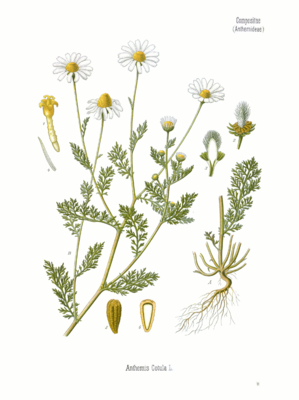Smelly dog chamomile
| Smelly dog chamomile | ||||||||||||
|---|---|---|---|---|---|---|---|---|---|---|---|---|

Smelly dog chamomile ( Anthemis cotula ), illustration |
||||||||||||
| Systematics | ||||||||||||
|
||||||||||||
| Scientific name | ||||||||||||
| Anthemis cotula | ||||||||||||
| L. |
The smelly dog chamomile ( Anthemis cotula ) is a species of the sunflower family (Asteraceae).

description
The highly branched annual plant grows up to 45 cm high and has scattered hairs on both the irregularly pinnate leaves and the stem. The initially flat, later conical, double flower heads are composed of white ray-like and yellow tubular flowers . The latter have chaff leaves without a spike tip. The plant, which blooms from July to September, emits an unpleasant odor.
The number of chromosomes is 2n = 18.
Occurrence
The distribution area includes Europe, North Africa, West Asia, the Caucasus, the Arabian Peninsula and the Indian subcontinent. In addition, the smelly dog chamomile is a neophyte in North and South America, southern Africa, Macaronesia, Australia and New Zealand. In Germany it grows absent-mindedly to rarely preferentially on weed debris and fields. It thrives on moderately fresh to fresh, nutrient-rich and base-rich, neutral, humus-rich loam and clay soils. It is a species of the Secalietea class, but also occurs in societies of the Sisymbrion association.
Allergenic effect
Presumably, intolerance and allergic reactions, which are often attributed to real chamomile ( Matricaria chamomilla ), are mainly due to confusion and adulteration with the smelly dog chamomile. The sesquiterpene lactone anthecotulide contained in it externally causes severe skin irritation, conjunctivitis and allergic reactions of the respiratory organs in sensitive people . Taken as tea, the mucous membranes are often irritated, which is perceived as a burning sensation in the stomach and can lead to anaphylactic shock .
Taxonomy
The scientific name Anthemis cotula was first published in 1753 by Carl von Linné in Species Plantarum .
Common names
For the stinking dog chamomile, the names Crotuntille ( Old High German ), Dickkopp ( Altmark ), Gänsekropf ( Thuringia ), Hillige Dille ( Silesia ), Hundsblom ( Mecklenburg ), Hundsblume , Hundsdyl , Hundskamelle , Hundsdille , are or were, partly only regionally , dog Chamomile (Silesia), Hundsroney ( Prussia ), Hunneblomen ( lower Weser ), Hunssblumen ( middle Low German ), Kröttenblume , Krottendill , Kühblumen ( medium high German ), Kühdill (medium high German), Kuhdistel (medium high German), Kuhtistel (medium high German), Paddeblom , Wäld Zäckwih ( Transylvania ) and stink chamomile common.
swell
literature
- Lutz Roth, Max Daunderer, Kurt Kormann: Poison Plants - Plant Poisons. Occurrence, effect, therapy, allergic and phototoxic reactions; new: with a special section on poisonous animals. 5th expanded edition. Nikol, Hamburg 2008, ISBN 978-3-86820-009-6 .
- Richard Fitter, Alastair Fitter, Marjorie Blamey, Konrad von Weihe (translator): Parey's flower book. Flowering plants from Germany and Northwest Europe. 3. Edition. Parey Buchverlag Berlin 2000, ISBN 3-8263-8524-1 .
- Harry Diener: Drug science. 4th edition. Fachbuchverlag Leipzig 1965, p. 175.
- Achim Meyer: Isolation and analysis of anthecotulide from Anthemis cotula L. Diploma thesis, Martin Luther University in Halle-Wittenberg 2003 ( PDF file; 469 kB ).
Individual evidence
- ↑ a b Erich Oberdorfer : Plant-sociological excursion flora for Germany and neighboring areas . With the collaboration of Angelika Schwabe and Theo Müller. 8th, heavily revised and expanded edition. Eugen Ulmer, Stuttgart (Hohenheim) 2001, ISBN 3-8001-3131-5 , pp. 932 .
- ^ A b Anthemis in the Germplasm Resources Information Network (GRIN), USDA , ARS , National Genetic Resources Program. National Germplasm Resources Laboratory, Beltsville, Maryland. Retrieved February 16, 2018.
- ↑ Carl von Linné: Species Plantarum. Volume 2, Lars Salvius, Stockholm 1753, p. 894 ( digitized version ).
- ^ Georg August Pritzel , Carl Jessen : The German folk names of plants. New contribution to the German linguistic treasure. Philipp Cohen, Hannover 1882, p. 31 (online).
Web links
- Smelly dog chamomile. In: FloraWeb.de.
- Smelly dog chamomile . In: BiolFlor, the database of biological-ecological characteristics of the flora of Germany.
- Profile and distribution map for Bavaria . In: Botanical Information Hub of Bavaria .
- Anthemis cotula L. In: Info Flora , the national data and information center for Swiss flora .
- Distribution in the northern hemisphere from: Eric Hultén, Magnus Fries: Atlas of North European vascular plants. 1986, ISBN 3-87429-263-0 at Den virtuella floran. (swed.)
- Thomas Meyer: Dog chamomile data sheet with identification key and photos at Flora-de: Flora von Deutschland (old name of the website: Flowers in Swabia )